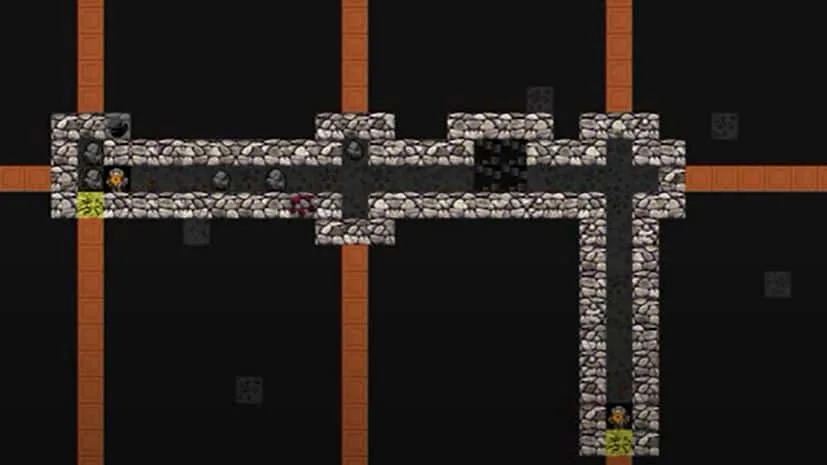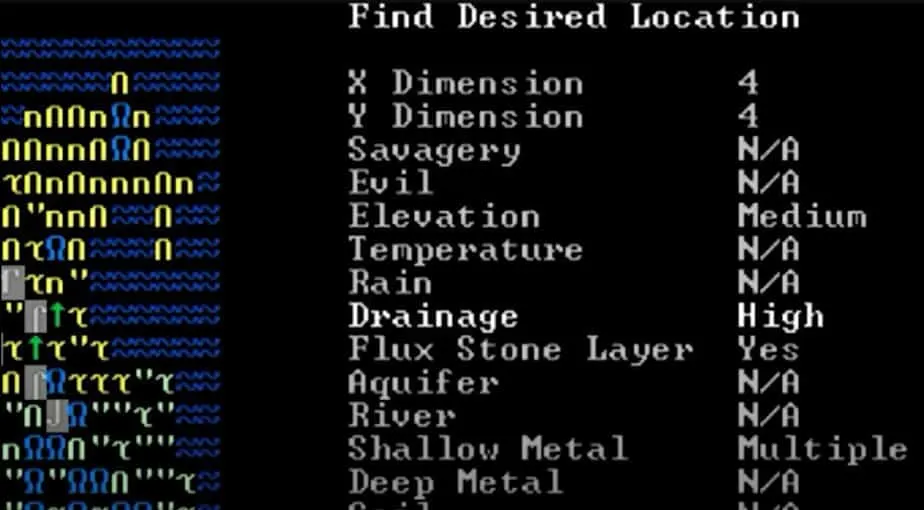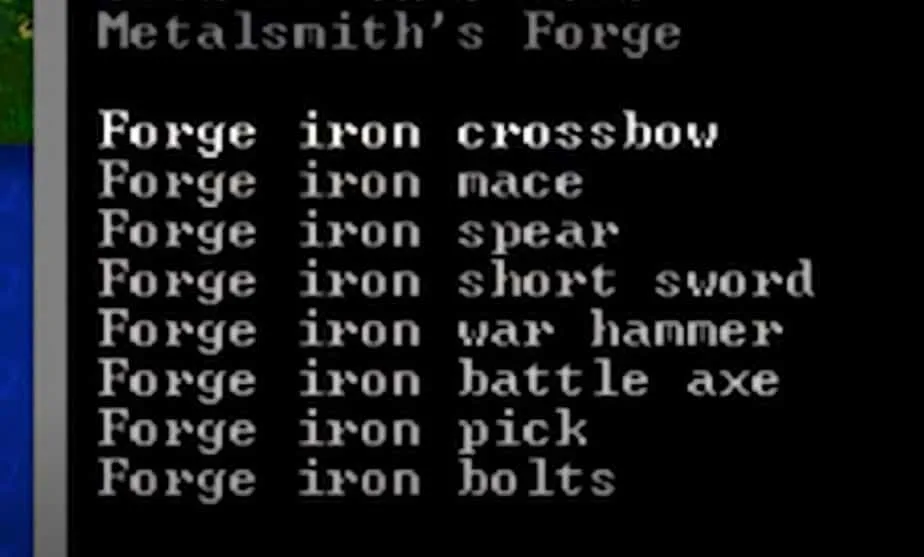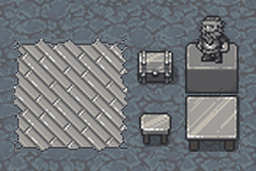|
|
|||||||||||||||||||||||||||||||||||
|
|||||||||||||||||||||||||||||||||||
| Используется | |||||||||||||||||||||||||||||||||||
|---|---|---|---|---|---|---|---|---|---|---|---|---|---|---|---|---|---|---|---|---|---|---|---|---|---|---|---|---|---|---|---|---|---|---|---|
|
|||||||||||||||||||||||||||||||||||
| Руда | |||||||||||||||||||||||||||||||||||
|
|||||||||||||||||||||||||||||||||||
| Свойства | |||||||||||||||||||||||||||||||||||
|
|||||||||||||||||||||||||||||||||||
|
Статья в википедии |
Железо — важный ресурс для вашей крепости, широко распространённый материал, используемый для изготовления практически всего, что необходимо: от оружия до мебели и товаров на продажу. Железо также является необходимым ингредиентом при производстве стали, “почти” лучшего металла в игре для оружия и брони. Если вы не в состоянии производить достаточное количество стали в вашей крепости, то следующим наилучшим металлом для военных целей является железо.
Железо добывается из трёх видов руды: красный, бурый и магнитный железняк. Они встречаются только во всех слоях, за исключением бурого железняка, который встречается только в осадочных эффузивных слоях.
Обратите внимание, что железо не ржавеет (хотя такое может появиться в будущих версиях), поэтому нет ничего страшного в том, что железные предметы лежат под дождем или упали в воду.
Применения
- Оружие ближнего боя. В основном полезно для острого оружия. Хорошо подходит и для болтов. Вы также можете сделать арбалеты из железа, но есть материалы получше.
- Броня. Он неплохой материал, хотя и не лучший.
- Строительство, если сильно захочется.
- Хорошая дорогая мебель. При этом он довольно тяжелая.
- Магмоупорные механизмы, хотя существует множество магмоупорных пород, которые не будут ничем хуже, если их получится достать.
- Наковальни, которые можно сделать только из железа или стали.
Производство
Железо можно получить из трёх видов руды: красный (самый распространённый), бурый (самый лёгкий) и магнитный железняк (залегает большими кластерами).
Любую из этих железных руд можно переплавить в плавильне для получения четырех железных слитков. Если у вас есть обычна плавильная печь, потребуется единица топлива; магма-плавильням не требуется топливо для работы.
Наряду с караванами дварфов и людей, гоблины, нападающие на Вашу крепость, могут быть источником железа, так как зачастую носят железные доспехи и оружие. После удачной обороны крепости эти предметы, снятые с тел убитых гоблинов, могут быть переплавлены в железные слитки.
Сплавы
Железо можно сплавлять с различными материалами в плавильне для образования сплавов:
- Чугун = Железо + Флюс + Топливо
- 2х Сталь = Железо + Чугун + Флюс + Топливо
Обратите внимание, что топливо используется в качестве компонента реакции: даже в магма-плавильне требуется топливо для проведения реакций с использованием железа. Это согласуется с процессом науглероживания железа и чугуна в черной металлургии в реальной жизни.
| Дварфийский: | datan |
|---|---|
| Эльфийский: | icori |
| Гоблинский: | dusna |
| Язык людей: | uzin |
|
Raws |
|---|
|
Dwarfoloid picked out a lot of the material numbers here to replace my placeholders. [INORGANIC:IRON] |
|
V · T · E Металлы |
|
|---|---|
| Основные |
Aluminum • Bismuth • Copper • Gold • Iron • Lead • Nickel • Platinum • Silver • Tin • Zinc |
| Сплавы |
Billon • Bismuth bronze • Black bronze • Brass • Bronze • Electrum • Fine pewter • Lay pewter • Nickel silver • Pig iron • Rose gold • Steel • Sterling silver • Trifle pewter |
| Особые |
Adamantine • Divine metals |
На чтение 2 мин Просмотров 127 Опубликовано 17 декабря, 2022
Не можете выковать железное снаряжение? Ознакомьтесь с нашим руководством о том, как найти железо в Dwarf Fortress.
В Dwarf Fortress есть множество предметов и ресурсов, которые можно использовать для разных целей. Один из них включает металл железа. Его можно использовать для торговли товарами, мебелью, оружием и доспехами. Вы можете использовать его для производства стали, которую можно использовать для нескольких военных целей. Вы также можете использовать железо для ковки различных типов сплавов. Но некоторые игроки не могут найти этот металл нигде в мире. Не беспокойтесь, ознакомьтесь с нашим руководством о том, как найти железо в Dwarf Fortress.
Как найти железо в Dwarf Fortress
К сожалению, вы не можете найти или получить Железо напрямую по всему миру. Вы можете получить железо только из трех типов руд в Dwarf Fortress. Вот эти три железных руды:
- гематит
- магнетит
- Лимонит
Вы можете найти все перечисленные выше железные руды в осадочных слоях. Это первый слой, который вы найдете под землей. Но иногда вы можете найти гематит в магматических экструзивных слоях.. К ним относятся слои риолита, базальта, андезита, дацита и обсидиана. Когда вы найдете железную руду, вам будет предложено найти железную руду.
Кроме того, вы также можете нажать “Найти нужное место” вариант. Для этого нужно изменить некоторые параметры. Они заключаются в следующем:
- Слой флюсового камня: Да
- Мелкий металл: Несколько
- Высота >: средний
- Осушение: многократный или высокий
Несмотря на это, нет никакой гарантии, что вы найдете какую-либо железную руду, изменив эти Параметры. Но вы можете отправиться на разные слои осадочных камней, чтобы найти железные руды. Ниже перечислены все слои осадочных камней, которые вы можете найти:
- Глиняный камень
- Каменная соль
- Известняк
- Конгломерат
- Песчаник
- Алевролит
- Аргиллит
- Сланец
- Доломит
- Черт
- Мел
Получив в свои руки любую железную руду, вы можете переплавить ее в кузнице Mealsmith’s . Вы получите четыре железных слитка в обмен на переплавку руды в кузнице. Затем вы можете изготовить несколько видов железного оружия из железных слитков.
Это все, что нужно знать о том, как найти железо в Dwarf Fortress. Если вам понравилось это руководство, ознакомьтесь с другими нашими руководствами по как хоронить мертвых, как построить храм, что такое грибок на полу и дополнительные руководства по Dwarf Fortress прямо здесь, на Guideer.
На чтение 2 мин Просмотров 394 Опубликовано 12 декабря, 2022
Давайте узнаем, как найти железо в Dwarf Fortress!
В Dwarf Fortress игрокам предстоит строить и строить лучшую крепость для своих гномов и размещать все постройки, которые им нужны, чтобы поддерживать их хорошее настроение и здоровье. Однако вам нужно будет иметь много ресурсов, потому что ничего нельзя построить бесплатно. Железо — один из важных ресурсов, который необходим для изготовления мебели и оружия, и им даже можно торговать.
В этом руководстве мы покажем вам, как найти железо в Dwarf Fortress!
Как найти железо – Dwarf Fortress
Одним из самых важных ресурсов и металлов, которые можно использовать в Dwarf Fortress, является железо. Это имеет большое значение, когда речь идет о создании оружия и мебели в игре. Кроме того, это самый необходимый материал для производства стали.
В игре железо встречается в трех различных типах.
- Гематит
- Магнетит
- Лимонит
Магнетит и лимонит можно найти только в осадочных слоях, тогда как гематит иногда можно найти в изверженных экструзивных слоях.
Осадочный слой обычно является первым слоем, которого вы достигаете под верхними слоями почвы. Как только вы обнаружили осадочный слой, вы должны начать разведочную шахту. Самый эффективный способ поиска полезных ископаемых — в сетке.
Вам нужно прокопать один широкий проход по лестнице до самого левого и правого края карты, а затем пересечь его туннелями одинарной ширины, идущими от верхней части карты к нижней через каждые 10 клеток. .
Вашим гномам потребуется время, чтобы добыть этот образец, и, в конце концов, вы должны увидеть объявление внизу экрана с надписью «Вы нашли», а затем название минерала, который вы нашли.
Чтобы увидеть, где именно находится материал, переместите стрелку к элементу в списке объявлений, а затем нажмите «Z». Игра автоматически приблизится к месту, где находится материал, и наведет курсор на этот блок.
Вы также получите эти объявления как для драгоценных камней, так и для руд, но вам придется сосредоточиться на железе. Как только вы найдете руду, которую хотите добыть, дважды нажмите «D», чтобы открыть меню добычи, а затем нажмите «A», чтобы переключиться на автоматическую добычу.
Dwarf Fortress features plenty of resources and items for players to upgrade their gear but what becomes tedious is finding the right resources to revamp your armor and weapons. To be specific, we’re talking about Iron.
Go through the Magnetite, Limonite, and Hematite Ores to extract Iron in Dwarf Fortress. Alternatively, you can revamp the Parameters to find more Iron Ore. Go through the different Sedimentary Layers until you’re prompted with Iron Ore at the bottom of the screen, and then extract Iron Bars at the Mealsmith’s Forge.
What’s so special about Iron is the fact that it can be traded or used to craft weapons, armor, furniture, and even goods. You could go the route of upgrading it to steel which can be used for various other purposes too and there are alloys.
How to Deconstruct Walls in Dwarf Fortress?

So, there’s a lot that you can do with Iron in Dwarf Fortress but how on Earth do you get your hands on this precious commodity in the game world?
Find it in Different Ores
Getting your hands on Iron is not as direct and simple as one would expect. The only way you can get your hands on Iron is to extract it from different types of Ores found around in Dwarf Fortress. A few Ores that are rich in Iron are listed below:
- Magnetite
- Hematite
- Limonite
Sift Through the Sedimentary Layers
To get your hands on these Ores, you’ll have to go through the Sedimentary Layers found within the game. The Sedimentary Layer is the first layer found under the soil. But going deeper, you might wind up finding Hematite Ores in the Igneous Extrusive Layers. These are many including the Obsidian, Andesite, Dacite, Basalt, and Rhyolite Layers.
So, how do you know you’ve come across Iron? Well once you come across Iron in Dwarf Fortress, you’ll be prompted that you’ve hit upon Iron Ore.
Change up The Parameters

You can also change up your parameters to possibly increase your chances of striking Iron in the game. You’ll have to select the Find Desirable Location Option for this. The following parameters might help you increase your chances of finding this precious resource.
- Shallow Metal: Multiple
- Drainage: Multiple or High
- Flux Stone Layer: Yes
- Elevation: Medium
Go Through the Different Sedimentary Layers
Still, there’s no guarantee you’ll increase your chances of hitting upon Iron by changing up these Parameters. But you can still navigate through the different layers in Dwarf Fortress to come across Iron. Here’s a compiled list of all the different Sedimentary Layers where you might find Iron:
- Rock Salt
- Conglomerate
- Claystone
- Sandstone
- Siltstone
- Mudstone
- Shale
- Chert
- Chalk
- Dolomite
Head Over to the Mealsmith’s Forge

Going through all the steps mentioned above, you’ll increase your chances of coming across Iron Ore in Dwarf Fortress. Once it’s all said and done, and you find enough Iron Ore for your escapades, you can smelter Iron Ore by heading over to the Mealsmith’s Forge.
By smelting a single Iron Ore, you’ll get your hands on a total of Four Iron Bars. Now comes the easy part. You can use these Iron Bars to craft different weapons and armor pieces to improve your Dwarf Fortress experience.
Conclusion
And that’s pretty much all you need to know to start looking for Iron Ore in Dwarf Fortress. But that’s not all, we’ve got more interesting guides to enhance your gaming experience. So, stay tuned for more!
Mastering a metal industry in Dwarf Fortress will ensure your fortress is economically prosperous and that your military can defend it. Mining, smelting, and crafting metals lets you make weapons and armor for your military, or just make fancier trade good and furniture. But it’s not always easy to know what ores smelt into what metals or how to make alloys.
Our Dwarf Fortress metals guide will help you understand what ores you’re finding, set up your metal industry, and start making valuable alloys and weapons.
Metal industry from start to finish
Any metal industry in Dwarf Fortress starts with finding metal ore. That’s the easy part, really. You’ll find metal ore just by digging — it’ll get left behind as you dig through certain types of rock.
From there, you’ll need to smelt the ore in a Build (b) > Workshop (o) > Furnaces (u) > Smelter (l). Smelting also requires fuel, though. That comes from charcoal made from logs in a Build (b) > Workshop (o) > Furnaces (u) > Wood Furnace (f) or from either bituminous coal or lignite turned into coke at a Smelter.
Smelting produces metal bars that are then worked at a Build (b) > Workshops (o) > Metalsmith’s Forge (i). That’s where you’ll make everything from weapons to furniture to instruments — a process that uses more fuel.
Types of metal ore in Dwarf Fortress
There are 12 types of metal that come from the 17 different metal ores you might find underground in Dwarf Fortress.
Dwarf Fortress metal ores and metals
| Ore | Metal |
|---|---|
| Ore | Metal |
| Bismuthinite | Bismuth |
| Cassiterite | Tin |
| Galena | Lead, Silver |
| Garnierite | Nickel |
| Hematite | Iron |
| Horn silver | Silver |
| Limonite | Iron |
| Magnetite | Iron |
| Malachite | Copper |
| Native Aluminum | Aluminum |
| Native Copper | Copper |
| Native Gold | Gold |
| Native Platinum | Platinum |
| Native Silver | Silver |
| Raw Adamantine | Adamantine |
| Sphalerite | Zinc |
| Tetrahedrite | Copper, Silver |
Dwarf Fortress metal ores and the metals they produce when smelted.
Smelting one piece of each of the above metal ores at a Smelter will produce four bars of metal. For the two ores that produce two different metals — Galena and Tetrahedrite — four bars of the first metal listed will be produced along with up to four bars of the second metal.
Raw Adamantine is slightly different. Raw Adamantine needs to be processed first at a Craftsdwarf’s Workshop with Extract Metal Strands. Those strands are then woven into cloth at a Loom (and then into Adamantine clothing at a Metalsmith’s Workshop) or made into Adamantine Wafers at a Smelter.
Combining those 12 metals at a Smelter lets you make an additional 14 Alloys.
Dwarf Fortress Alloys
| Alloy | Ingredients |
|---|---|
| Alloy | Ingredients |
| Billon | 1 Silver, 1 Copper |
| Bismuth Bronze | 1 Tin, 2 Copper, 1 Bismuth |
| Black Bronze | 2 Copper, 1 Silver, 1 Gold |
| Brass | 1 Zinc, 1 Copper |
| Bronze | 1 Tin, 1 Copper |
| Electrum | 1 Silver, 1 Gold |
| Fine Pewter | 3 Tin, 1 Copper |
| Lay Pewter | 2 Tin, 1 Copper, 1 Lead |
| Nickel Silver | 2 Nickel, 1 Copper, 1 Zinc |
| Pig Iron | 1 Iron, 1 Flux stone, 1 Fuel |
| Rose Gold | 3 Gold, 1 Copper |
| Steel | 1 Iron, 1 Pig Iron, 1 Flux, 1 Fuel |
| Sterling Silver | 3 Silver, 1 Copper |
| Trifle Pewter | 2 Tin, 1 Copper |
Dwarf Fortress Alloys and how to make them.
When you create an Alloy at a Smelter, you’ll have the choice to either use ore or use bars. Using bars is less efficient, producing two bars of Alloy for each operation (1 Silver Bar and 1 Copper Bar produce 2 Billon Bars). Using ores, on the other hand, produces eight bars (1 Zinc ore and 1 Copper ore produce 8 Bronze Bars).
Pig Iron and Steel require additional materials. In addition to extra bars of charcoal or coke, you’ll also need Flux stone — Calcite, Chalk, Dolomite, Limestone, or Marble.
Metal and Alloy values
Below, we’ll list the value — the base rate you’d get when trading with a Caravan — of a single bar of each Metal or Alloy.
Dwarf Fortress Metal and Alloy values
| Metal or Alloy | Value |
|---|---|
| Metal or Alloy | Value |
| Adamantine | 300 |
| Aluminum | 40 |
| Platinum | 40 |
| Gold | 30 |
| Steel | 30 |
| Rose gold | 23 |
| Electrum | 20 |
| Black bronze | 11 |
| Iron | 10 |
| Pig iron | 10 |
| Silver | 10 |
| Sterling silver | 8 |
| Brass | 7 |
| Billon | 6 |
| Bismuth bronze | 6 |
| Bronze | 5 |
| Fine pewter | 5 |
| Trifle pewter | 4 |
| Lay pewter | 3 |
| Nickel silver | 3 |
| Bismuth | 2 |
| Copper | 2 |
| Lead | 2 |
| Nickel | 2 |
| Tin | 2 |
| Zinc | 2 |
The value of a single bar or each Metal or Alloy.
The base value of a bar of each Metal and Alloy lets you see how (relatively) valuable something created from that metal would be — a Gold throne will be worth more than one made from Bronze, for example.
Metal and Alloy uses in Dwarf Fortress
Every metal can be used in Construction — building things like floors, walls, and Workshops. Every metal except Bismuth can be used in making furniture (things like cabinets, barrels, and thrones) and metal crafts (like earrings, goblets, and crowns).
Picks can only be made from Adamantine, Bismuth Bronze, Bronze, Copper, Iron, and Steel.
Anvils need to be Adamantine, Iron, or Steel.
Armor and Weapons can only be Adamantine, Bismuth Bronze, Bronze, Copper, Iron, or Steel.



